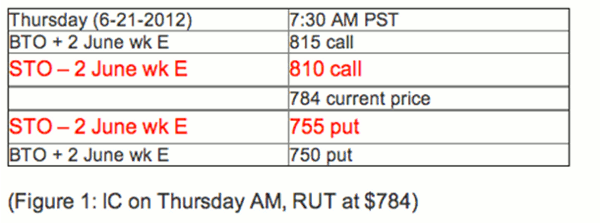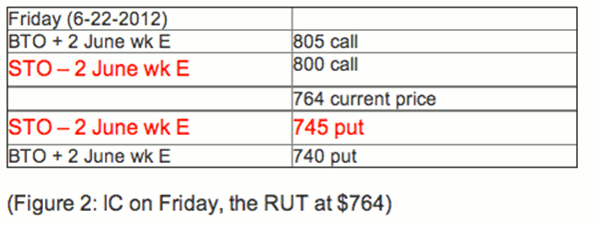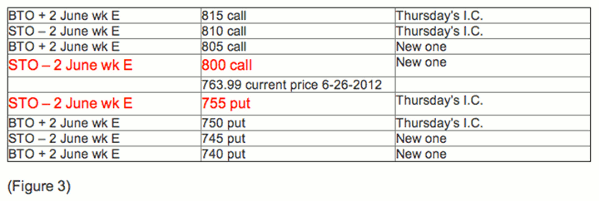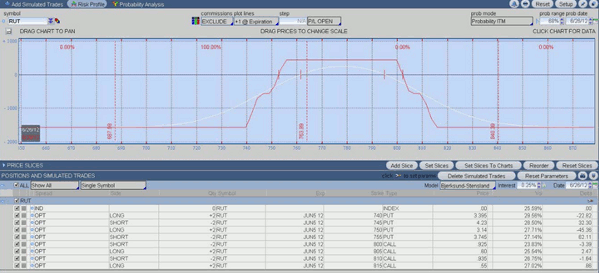Josip Causic of Online Trading Academy explains how adjusting an iron condor option trade can assist you in making the most money possible from the position.
One of the questions that traders of Iron Condors face is adjustment. There are multiple choices that can be made, but each one of them should be viewed as a separate trade. Among the many possibilities there is a choice of placing another Iron Condor (IC) within the original IC.
Below is a specific example. On Thursday morning, June 21, the Russell 2000 cash settled index was trading at $784, with a weekly ATR (Average True Range) of about 30 points. After attempting several ICs with different strike levels, the following one executed twice.
At the time of entry, the volatility was so low that for the moment, I was questioning the wisdom of executing this trade. Anyhow, the possible rate of return (25%) within a week looked worthwhile for taking the risk.
The total credit for the IC was 0.99 and each wing spread was five points wide; hence the max risk is (5.00-0.99) 4.01. Once again, this trade was done on Thursday morning, June 21, and by midday Friday, the RUT dropped almost 20 handles from 784 to 764.
At that point, the sold 755 put was still OTM by nine points, but there were still many days left until the June week expiration was on June 29. Up to that Friday, the weekly ATR was 30 handles, and then in a single day trading session, abnormality kicked in and the RUT dropped 20 points. The question became, what to do then?
The choice of taking the max loss and being passive is always there, so personally, I do not even consider it a choice, especially not the correct choice. If the option strategy no longer matches the initial market forecast opinion, then be active and make savvy adjustments. I chose to move with the market and entered another IC, only using different strike levels. Figure 2 shows the specifics.
Due to the increase in implied volatility, I was able to obtain an even richer premium (1.16) than initially. However, keep in mind that more money was thrown at the same underlying.
The wing strike spread is still five-points (5.00-1.16) and 3.84 per contract is at risk. From the broker’s perspective, there are four Iron Condors currently on, with a five-point wing strike spread (4×500); so there is 2K involved in this particular trade. Figure 3 shows all the strikes together.
Ideally, if the Russell 2000 index stays between the sold 800 call and 755 put, both condors would produce the maximum profit. To make the presentation of this new Iron Condor within Thursday’s IC even more visual, I took a snap shot of the Risk Profile.
The explanation of the graphic above is beyond the scope of this article, yet the point is that the current price of 763.99 at the time of writing is sitting in that ideal zone for achieving its max profit. It is in between the sold 800 call and 755 put
Although technically speaking, the second IC was not within the first (only the Bear Call component of the new IC was within the initial IC), we still have an IC within an IC.
The main point is that if the selected strike prices are no longer accurate, do not stay passive, be proactive. Look at the possibilities of placing another trade on for the correct reason. Then focus on the outcome of the aggregate of both positions. Good luck and know your options strategies well before trading them.
Josip Causic can be found at Online Trading Academy.

























